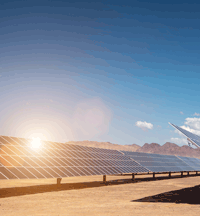The Bring Your Own Energy (BYOE) Party Is Starting
America is about to shift to decentralized energy and microgrids in a big, big way.
Q2 2024

Pearl Street Station only survived for five years, but it sparked a revolution in large American cities. Throughout the 20th century, power plants emerged across the U.S. promising manufacturers the availability, quality, and affordability of power they needed. It was as if someone started an energy party with a cash bar.
Innovation boomed, and by the turn of the century America was abuzz with cutting-edge technology, like electric street cars, telephones, light bulbs, and refrigerated box cars. Industrial equipment began to reshape commerce along with the human experience. Dispatchable power generation was the key.
In 2024, it's a different world. The limitations of dispatchable power are being tested by this era’s cutting-edge technology, and the global theater for energy is being reshaped by a barrage of twenty-first-century economic and socioeconomic forces. Industries, along with the threaded patchwork of power providers that serve them, are realigning strategies at a rate not witnessed since the inception of the electric utility.
Change is necessary. With nearly seven billion smartphone users accessing mobile apps, streaming services, and on-demand AI assistants, there is an insatiable requirement for more computing power and data centers. Edison’s Pearl Street Station could only offer enough electricity to run a few cabinets in one of today’s ultra-high-density data centers, and the installations based on the dispatch model are beyond strained.
Locally controlled microgrids might be the answer. Microgrids can supplement — and maybe one day replace — the large power plants strung across vast transmission networks that we refer to as the electric grid. Exciting engineering breakthroughs in next-generation energy systems have already enabled a growing share of companies to create these supplementary systems to help secure their energy future. They’re bringing their own to the energy party.
As the clean energy inflection point becomes clearer, more and more site selection and facility strategists are looking past the cash bar and are adopting a BYOE approach, too.
A Business Case for the Decentralization of Energy
Onsite power generation, or the production of energy at the point of use, is hardly a new concept. Mission-critical systems and industrial facilities have long since turned to onsite energy solutions for contingencies such as emergency backup power, redundancy beyond the scope of local utility providers, and broad reaching protection from consequences of being tied to the wider electric grid. In many cases, revenue streams also exist if surplus power is sold back to the grid.
But with global volatility and weather disasters on the rise, manufacturers, data centers, healthcare facilities, financial services, telecommunications, public safety systems, and other sectors have taken this BYOE approach to location and operational decision-making in order to achieve better control of their energy. These companies have unique reliability standards required of them. Many are partnering with increased frequency with utility companies to design bespoke, cutting-edge energy solutions for a growing share of large energy users.
Cloud-based business adaptations and data-driven manufacturing processes responding to today’s digital economy have a lower tolerance for power vulnerability, forcing even those without robust carbon-reduction goals to consider sustainable, adaptable, and in many cases carbon-free energy solutions.
While onsite battery systems, generators, and fuel reserves were traditionally planned with power outages in mind, more robust solutions are now being deployed within industrial settings to offset transmission and generation constraints, hedge against fuel costs and pricing sways through peak shaving methods, and chip away at long-term carbon-emission strategies. Presently, certain U.S. energy portfolio shortfalls are further encouraging the adoption of microgrid systems that can satisfy greater electric demands. Powering these microgrids are energy technologies such as battery storage, combined heat and power, thermal storage, solar, water, and wind, with newer solutions such as small nuclear reactors (SMRs) under development.
Edison’s Pearl Street Station could only offer enough electricity to run a few cabinets in one of today’s ultra-high-density data centers, and the installations based on the dispatch model are beyond strained. Energy sovereignty and security are among the most encompassing drivers and intrinsically valuable benefits of a decentralized grid. Separation not only allows users to curate their own energy portfolio. It also shields microgrid adopters from damaging weather, climate, and security concerns associated with the wider U.S. grid. NOAA reported 28 separate billion-dollar weather and climate disasters that impacted the U.S. in 2023. At the same time, the digitization of the economy has incentivized U.S. adversaries to target critical infrastructure through physical and cyber plots. Asset intelligence firm Armis recently reported that cyberattacks on utilities increased by more than 200 percent in 2023, with overall cyberattacks increasing by 104 percent.
Another benefit is the mix of alternative energy sources inherent to a microgrid. Millennials and Gen-Z have begun to seize control of the world’s largest consumer markets. They’re the chief patrons of service providers and manufacturers around the world, and these value-based consumers’ behaviors are increasingly shaped by carbon considerations.
Data released by the federal reserve shows that trillions worth of assets will change hands from one generation to another with every coming decade. The companies that court them, and others within their orbit, are positioning to appeal to a much different customer.
Corporate energy strategists must now appeal to these customers while dealing with the fallout of transmission constraints and a strained U.S. energy regulatory environment.
Behind the Meter, Ahead of the Curve
The capital considerations associated with these infrastructure challenges have attracted record levels of overseas investment and private equity aimed at renewable generation, grid modernization, next-generation feedstocks, and onsite energy solutions for industrial customers.
Whirlpool Corporation recently announced an agreement with One Energy to add onsite wind and solar power at its Findlay and Clyde, Ohio, operations, becoming one of the largest behind-the-meter renewable energy projects in the U.S. The onsite installations will supply 22 percent of the electrical needs for the facilities while ensuring the washing machine and dishwasher manufacturing operation receives at least 70 percent of its needs from onsite renewable generation. The project is supported by the Industrial Assessment Centers (IAC), a grant program funded by the Bipartisan Infrastructure Law.
A planned SMR at the Surry Green Energy Center in Virginia, and Fidelis New Energy’s hydrogen project and data center campus in Mason County, West Virginia, are just two recent examples of mission-critical projects planned with next-generation energy and infrastructure investments. Co-locating with large dispatchable nuclear generation, Amazon announced last year that it plans to build a 1.7-million-square-foot campus in Louisa County near the 1.79 GW North Anna Nuclear Plant. Uniquely positioned to be lifelong partners, nuclear generation and data centers are joining together to satisfy AI’s lust for power density.
Holcim AG, a global $40.5 billion market cap producer of concrete, is supplying data center operators like Amazon Web Services with lower-embodied carbon concrete. Materials like these contribute to AWS’s sustainable design standards, in line with their pledge to reach net-zero carbon emissions by 2040. To support these efforts, Holcilm U.S. recently announced the addition of a 25 MW solar field array to be installed at its Alpena, Michigan, plant. The solar installation allows the plant to self-generate 75 percent of its power needs. Similarly, the company added a 40MWh battery storage system in Colorado and wind generation in Ohio, stating it is evaluating on-site renewables at other U.S. manufacturing sites.
Earlier this year, DOE-funded Controlled Thermal Resources broke ground on a combined geothermal power plant and lithium extraction project at California's Salton Sea. The project will begin to hedge against the country’s growing dependence on foreign lithium, a mineral that is currently central to the nation’s clean energy transition. According to the U.S. Energy Information Administration, California, Nevada, Utah, Hawaii, Oregon, Idaho, and New Mexico — in that order — lead the country for geothermal electricity generation. Outside of bulk electricity generation, geothermal heating and cooling solutions are being used for different industrial applications like pulp and paper processing, and food dehydrating.
While these pioneers are investing in cutting- edge energy solutions, other exciting energy technologies still under development are positioned to further disrupt the traditional electric grid construct, and likely embolden the BYOE approach within the first half of the century.
Energy Advancements Disrupting Industrial Location Strategies
SMRs are a popular concept for future industrial applications. These nuclear reactors carry generation capacities up to 300 MW per unit by definition. Larger SMR designs could amount to roughly one-third of the generation capacity of traditional reactors. Conceivably, each module is constructed in a factory environment and shipped to the point of use. In addition to augmenting the power sources of individual users, SMRs will inevitably be well-suited to deploy and integrate across the country’s vast transmission network. Decommissioned coal facilities and other outdated sites tethered to critical intersections of transmission infrastructure will be suitable homes for SMRs.
NuScale, one of the leaders in SMR design, almost had the first one in commercial service in the U.S, before a setback in Utah created some uncertainty. The Nuclear Regulatory Commission had given approval to its 50 MW design. Opinions vary, but most experts now say the U.S. premiere of SMRs is likely to happen somewhere in the early to mid 2030s. Proven commercial operations in the country are still desperately needed.
With global volatility and weather disasters on the rise, manufacturers, data centers, healthcare facilities, financial services, telecommunications, public safety systems, and other sectors have taken this BYOE approach to location and operational decision-making in order to achieve better control of their energy. Clean hydrogen enthusiasts, especially the Bipartisan Infrastructure Law funded hydrogen hubs across the country, are closely watching the rollout of federal guidance required to subsidize billions of announced yet pending investments. That has not stopped early adopters like Amazon from deploying its own onsite solutions. Plug power, a New York headquartered developer of hydrogen fuel systems, recently announced the installation of its electrolyzer system (splitting water with electricity) at Amazon’s Aurora, Colorado fulfillment center. The one MW green electrolyzer will be used to fuel hydrogen powered forklifts and will aid in the company’s robust ESG goals. Onsite electrolyzers are largely viewed as a necessary milestone in the adoption of hydrogen fuel sources, as the energy it takes to simply liquify, store, and transport hydrogen has significant carbon consequences itself.
New designs for long duration energy storage systems (LDES) also serve as future disruptors for industrial facility considerations. The limitations of today’s battery storage systems present huge challenges for building highly efficient, sustainable, and resilient renewable onsite systems. LDES systems will ultimately play a pivotal role in the storage and dissemination of multiple energy generation sources, including proven industrial renewable strategies such as solar, hydro, and wind.
Cardinal Implications for Industrial
Robust onsite power technology solutions will impact the industry and the country in great and myriad ways. Its wide adoption will inflate investments into new and existing industrial facilities. It will rewrite credit and incentive strategies, monetize energy assets, flood utility rate cases with new behind-the-meter programs and economic development riders, and challenge the conventional producer-supplier-consumer energy model.
Microgrids and onsite generation tech will require more design-build expertise, bringing increased complexity but eventually more flexibility to industrial real estate considerations. Modular energy designs will take hold across more industrial market segments, bring life to outdated manufacturing facilities, and eradicate others. Federal and state energy policies will be challenged to keep pace with superior technologies, construction workers will have to reskill, new energy export markets will develop, and electric power equipment manufacturing will be tossed into the energy sovereignty contest and dissected on the political carving table.
It’s true that dispatchable and utility-scale energy investments are still being proposed across the country, but they are designed as bridging strategies, new generation projects intended to ease into a federally regulated renewable future. Yes, new natural gas fired plants are being sited, coal plant decommissioning is being delayed, and aging nuclear fleets are being granted an extended shelf life. But as the country’s voracious appetite for energy increases and the backlog of committed generation swells, a digitally transformed business community feels cornered, frightened, emboldened, and gradually capable of a more autonomous energy future.
More and more are going to bring their own energy, and that’s going to have a transformative effect on the country’s energy infrastructure.
Project Announcements
Canada-Based AVL Manufacturing Plans Charlotte, North Carolina, Manufacturing Operations
05/27/2025
Germany-Based Volektra Establishes El Dorado Hills, Headquarters Operations
05/26/2025
Apex Power Conversion Establishes Mesa, Arizona, Headquarters Operations
05/24/2025
Canada-Based Damera Corporation Plans Peoria, Illinois, Assembly Operations
05/21/2025
Reworld Plans Park Hills, Missouri, Material Processing Operations
05/16/2025
Green Recycle USA Plans Pittsylvania County, Virginia, Operations
05/16/2025
Most Read
-
20th Annual Area Development Gold and Silver Shovel Awards
Q2 2025
-
First Person: Joe Capes, CEO, LiquidStack
Q2 2025
-
The Legal Limits of DEI in Incentives Agreements, Hiring, and Contracting
Q2 2025
-
From Silicon to Server: Mapping the Data Center Supply Chain
Q2 2025
-
39th Annual Corporate & 21st Annual Consultants Surveys: What Business Leaders and Consultants Are Saying About Site Selection
Q1 2025
-
Rethinking Life Sciences Site Selection in a Resilient and Dynamic Market
Q2 2025
-
Top States for Doing Business in 2024: A Continued Legacy of Excellence
Q3 2024



